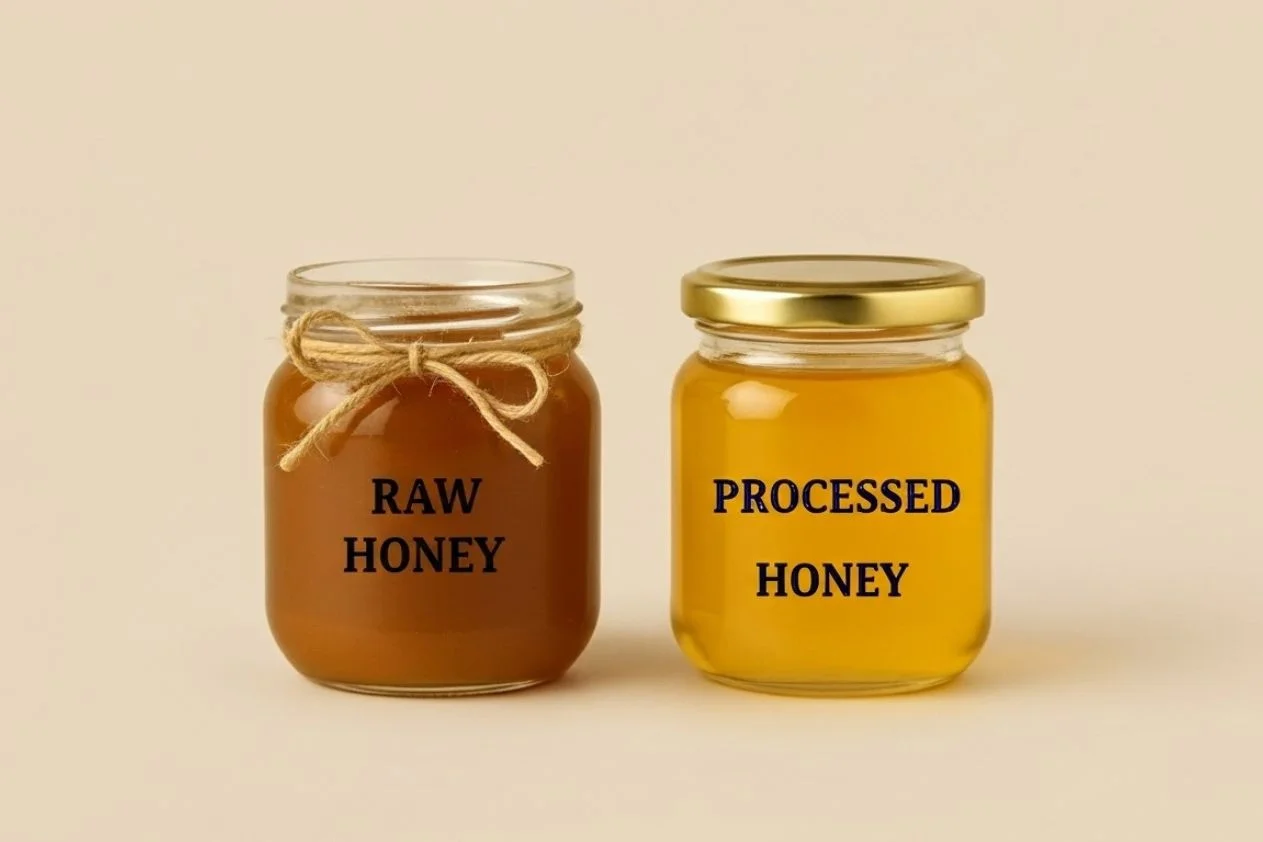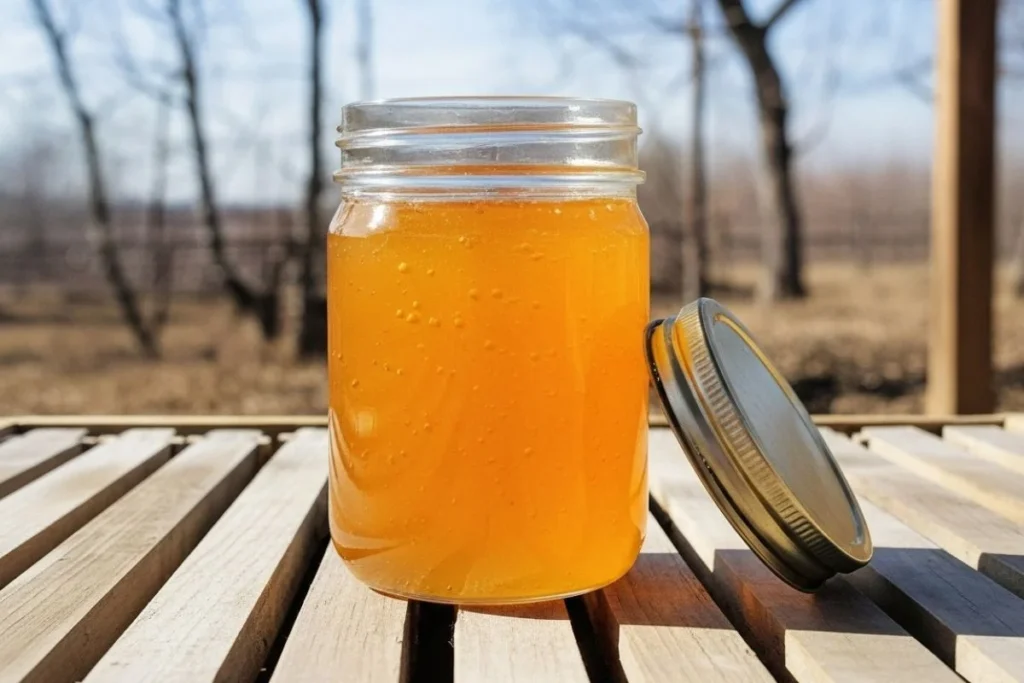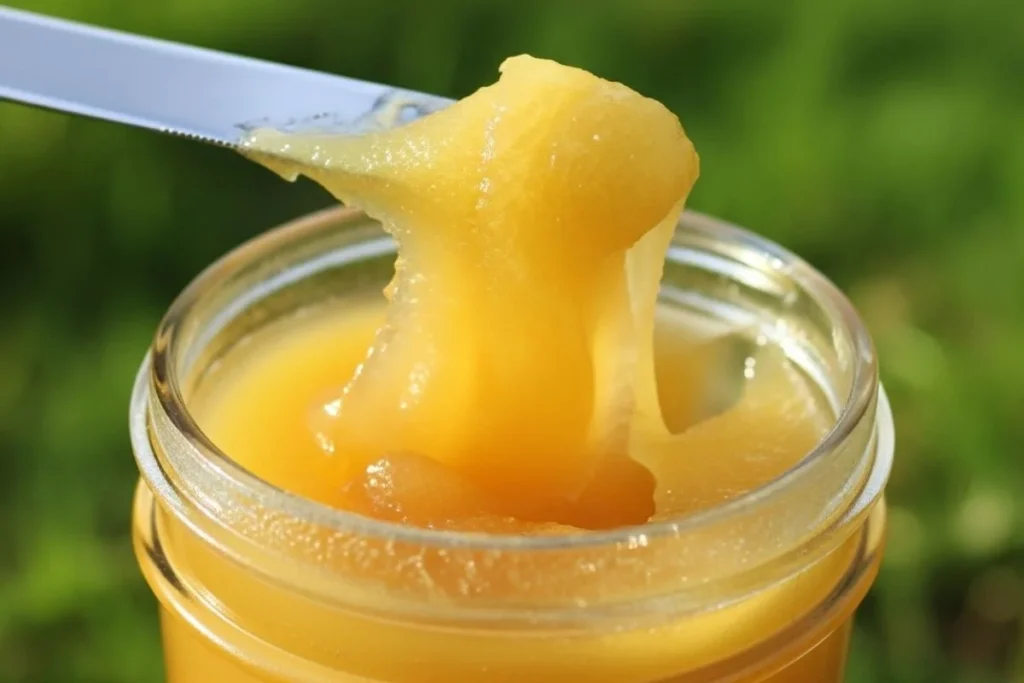

When it comes to choosing between raw and processed honey, the differences go far beyond taste. Health-conscious consumers are increasingly questioning which type offers superior wellness benefits. Do additional health advantages justify the extra cost of raw honey, or does processed honey provide similar benefits with better consistency?
Let’s explore the nutritional profiles and processing methods to help you make an informed decision about the health benefits of raw vs. processed honey.
Raw honey is honey in its purest form, just as the bees made it. It’s extracted from the honeycomb and strained to remove bits of wax and debris but undergoes no further processing.
This minimal intervention preserves the honey’s enzymes, pollen, propolis, and antioxidants. Raw honey typically appears cloudy or opaque with a thicker consistency than its processed counterpart.
The color and flavor of raw honey vary dramatically based on the flowers the bees visited. Some varieties crystallize quickly, which is a natural process that doesn’t affect quality.

Raw honey maintains all its natural components, including:
Processed honey takes several treatments before reaching store shelves. Commercial processing typically includes honey pasteurization (heating to 160°F or higher) and ultrafiltration.
This processing serves various functions, including killing yeast cells to extend shelf life, preventing honey crystallization, achieving a uniform appearance, and removing any impurities or particles.
According to a press release from Tauseef Khan, a senior researcher on the study and a research associate in nutritional sciences at the University of Toronto’s Temerty Faculty of Medicine:
“Conventional processing of honey involves straining and filtering and then heating for a short period to reduce moisture and yeast… but damages the honey, and many of its bioactive compounds lose their effect”.
Most commercial honey undergoes:
The processing methods create significant differences between raw and processed honey varieties that affect both nutritional content and potential health benefits.
| Nutrient/Component | Raw Honey | Processed Honey |
| Amino acids | 22 | Significantly reduced or absent |
| Minerals | 31 | Reduced levels |
| Antioxidants | It contains nearly 30 types of bioactive plant compounds (polyphenols) | Partially degraded. Contains up to 4.3 times fewer antioxidants than the raw variety |
| Pollen | Present | Removed |
| Propolis | Present | Removed |
| Sugar Content | Contaminated with sugar or other sweeteners like high fructose corn syrup |
Raw honey, or unfiltered honey, retains natural enzymes such as glucose oxidase, which are frequently destroyed during processing, reducing honey’s antimicrobial properties. These enzymes contribute to many of raw honey’s health benefits.
Raw honey contains bee pollen, which is rich in proteins, vitamins, minerals, beneficial fatty acids, and carotenoids. This component is completely filtered out of processed honey.
Pollen gives raw honey potential allergy-fighting properties, especially when the honey is locally produced. The theory suggests consuming local pollen in honey may help your body adapt to local allergens.
Raw honey typically has:

Processed honey features:
Raw honey crystallizes naturally over time as glucose molecules separate from water and form crystals. This process happens faster in raw honey due to the presence of pollen particles that serve as crystallization nuclei.
Crystallization is a sign of quality in raw honey and doesn’t affect nutritional value. Simply place the jar in warm water to return it to liquid form if desired.
Raw honey offers numerous health benefits thanks to its preserved natural components. Sweet Comb Chicago’s Pure Natural Local Honey exemplifies these qualities, being harvested directly from urban beehives and bottled without processing.
Raw honey contains powerful antioxidants, including flavonoids and phenolic compounds that help neutralize free radicals in the body.
These antioxidants may help reduce inflammation and protect against chronic conditions like heart disease. The darker the honey, the higher its antioxidant content typically is.
Raw honey possesses natural antibacterial properties thanks to its low moisture content, hydrogen peroxide production, and acidic pH.
These properties make raw honey effective for wound healing and fighting infections. Medical-grade honey is even used in clinical settings to treat wounds and burns.
The enzyme glucose oxidase in raw honey produces hydrogen peroxide when diluted, creating a natural antibacterial effect that processed honey often lacks.
The enzymes in raw honey support digestive processes and may help calm digestive issues. Raw honey has prebiotic properties that nourish beneficial gut bacteria.
Many people find that a spoonful of raw honey helps soothe sore throats and calm coughs more effectively than processed varieties or cough medicines.
Local raw honey contains small amounts of local pollen, which may help desensitize the body to these allergens over time.
While scientific evidence is mixed, many people report reduced seasonal allergy symptoms when consuming local raw honey regularly before and during allergy season.
This potential benefit is completely absent in processed honey since the pollen is removed during filtration.
Despite the processing, commercial honey still offers some health benefits and advantages over refined sugar.
Processed honey still contains:
Honey has a glycemic index (GI) score of 50, compared to refined sugar’s GI score of 80, indicating a slower blood sugar rise. This makes all honey, even processed varieties, a better option than refined sugar for blood glucose management.
Processed honey offers consistency in flavor, appearance, and texture that some consumers prefer:
When shopping for the most beneficial honey, consider these factors to ensure you’re getting a quality product.

Look for these terms on packaging:
Avoid products labeled simply as “pure honey” without specifying raw status, as these are typically processed. Also be wary of ultra-low prices, which often indicate diluted or imported honey of questionable origin.
Quality raw honey typically:
Robust flavors of honey from Sweet Comb Chicago exemplify these qualities with its natural crystallization patterns that vary with each harvest.
To maintain honey’s beneficial properties:
Properly stored raw honey can last indefinitely, though its appearance may change as it naturally crystallizes.
When comparing raw and processed honey, the evidence clearly points to raw honey as the superior choice for health benefits. Its preserved enzymes, antioxidants, and natural compounds offer advantages that processing diminishes or eliminates.
“Overall, the healthiest type of honey is raw, unprocessed honey, as there are no additives,” confirms Business Insider. The minimal processing preserves beneficial compounds that contribute to its antimicrobial, anti-inflammatory, and digestive benefits.
That said, even processed honey remains a healthier alternative to refined sugar. If raw honey isn’t available or affordable, regular honey still offers some benefits.
For those seeking maximum health benefits, locally produced raw honey like Sweet Comb Chicago’s provides not only nutritional advantages but also supports local beekeeping and environmental sustainability. Their urban honey harvesting practices ensure you receive truly raw honey with all its natural benefits intact.
Whether you choose raw or processed honey ultimately depends on your priorities – maximum health benefits or consistency and convenience. But understanding these differences empowers you to make an informed choice that aligns with your wellness goals.

Founder of Sweet Comb Chicago
